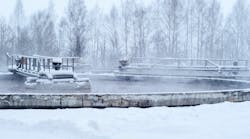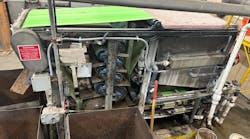At every wastewater treatment plant, the decision on how biosolids will be handled is typically a balancing act between the cost of processing and the disposal options. Approved landfill sites are seldom nearby. Sharp rising fuel costs for over-the-road transport and increased tipping fees have led plant operators to look for ways to reduce the amount of biosolids that must be handled.
The solution to the problem has always been twofold: reduce the mass and volume of material and increase the disposal options of the material. Mass and volume are significantly reduced by dewatering 13% to 30% dry solids.
In recent years, thermal drying, which reduces water content to 10% or less, has emerged as one of the most sustainable methods for balancing economic advantages with environmental stewardship. Thermal drying to 90% dry solids can provide up to an 85% reduction in mass and provide a U.S. EPA 503 Class A end product.
Thermal Drying
Thermally dried biosolids are typically categorized as Class A and most of the time these materials are also designated “Exceptional Quality.” This means that the dried biosolids have value, whether as fertilizer or as fuel. The thermal drying process also significantly reduces the odor of the final product.
Thermal drying processes vary, but the basic definition is the application of heat to evaporate water from biosolids. Either direct or indirect heating methods are used.
Direct. As implied by the term, direct heat dryer systems include a vessel or conveyance containing wet solids that are directly exposed to a stream of hot air or gas. The material heats up and evaporation takes place.
Indirect. In indirect thermal drying, the heating process is separate from the drying process. In this conductive heat-transfer process, the solids are dried by contact with the heated metal. Both methods are designed to capture most of the exhaust from the dryer chamber and recycle it to feed the furnace or reheat it for continued drying.
Because the thermal drying process has proven to be an effective alternative, many communities in the U.S. are now exploring ways to incorporate it into their operations to further increase efficiency. Minnesota communities have taken a lead by using innovative biosolids processing technologies that incorporate thermal drying.
Application in Action
A Kruger BioCon biosolids drying system was installed last year at a new water reclamation facility outside Minneapolis. The dryer capacity is 1,110 lb of 25% dry cake per hour and an outlet biosolids solid content of less than 90%. The dryer has a biosolids production rate of 305 lb per hour.
This installation was the first of its kind in the U.S., although several of these systems have been in operation in Europe for many years. A BioCon plant is also being installed this year in Le Sueur County, Minn., near Minneapolis. The unit is designed to dry 1,650 lb per hour of wet sludge at 18% dry solids content. The system also features dried sludge handling and storage. Dried biosolids will be land-applied.
How It Works
The BioCon drying process removes moisture from biosolids via an indirect convection belt dryer. A natural gas-fired boiler supplies the heat. Dewatered sludge cake is pumped from a wet bin into the dryer cabinet, and oscillating depositors extrude thin strings of sludge through rubber nozzles onto a slow-moving belt located inside the dryer. The long, thin strings provide for a large drying surface area, enabling low-temperature drying in two stages: a warm zone with a maximum operating temperature at 350°F and an end zone with temperatures around 210°F. Heat is then transferred to the biosolids by circulating air between air/liquid heat exchangers and the biosolids.
During the process, moisture is removed by continuously extracting a portion of air from the dryer. This air is transferred through a condenser and then returned to the dryer as new drying air. Drying occurs under a slight vacuum, providing minimal odor release. The temperature during the drying process decreases as the solids dry. In addition, the highest temperature is directed to the biosolids with the most moisture, whereas the driest biosolids receive the air with the lowest temperature.
Following drying, screw conveyers transport the solid material from the dryer.
A natural gas-fired boiler supplies heat for the drying process. Retention time, from when the solids come out of the depositor until they leave the dryer, is approxi-mately 90 minutes.
Although temperatures inside the dryer may reach 350°F, the outside case is well insulated and working area around the unit remains comfortable. The process does not produce a noticeable dust level, and the final biosolids material retains its shape throughout the storage and distribution process.
Full Circle: Energy Recovery System
U.S. wastewater treatment plants are also catching on to the idea of using dried biosolids to fuel the drying process—in other words, a biosolids furnace. This procedure has long been prevalent in Europe, where fuel has historically been costly and less land typically is available for land application.
Several years ago, representatives from Buffalo, Minn., toured a large number of wastewater treatment plants in Europe, looking at different biosolids treatment processes. Based on the group’s findings, the first BioCon Energy Recovery System (ERS) will be installed in Buffalo. Startup is scheduled for later this year.
The system will consist of a BioCon plant, much like those at the other two Minnesota facilities, but will also be outfitted with the innovative ERS. The biosolids furnace will convert the dried biosolids to energy that will then supply the majority of the BioCon dryer’s energy needs.
“The city of Buffalo is a very proactive community with an aggressive energy conservation policy,” said Brad DeWolf, city engineer and principal engineer with Bolton & Menk. When the community develops a project or buys equipment, its policy dictates that it purchases or specifies items that are energy efficient.
“Dried biosolids is what every operator wants, but every administrator that I have worked for doesn’t want to pay the natural gas bill that goes along with it,” DeWolf said. “Because of Buffalo’s strict energy conservation policy, we decided upon the Kruger BioCon Dryer with the Energy Recovery System to save natural gas costs.
The ERS will generate more than 80% of the heat required for drying our biosolids.”
In the system, heat from the ERS furnace is transferred to the BioCon dryer process via a circulation fan and heat exchangers. Air is blown over and through a slow-moving, water-cooled grate furnace to ensure maximum reduction of organic material. The off-gas, after being treated with activated carbon and sent to a bag filter, can then be released through a stack. As with the dryer, the BioCon furnace is designed for continuous or intermittent use.
Energy Savings
The system is projected to work safely 4,900 hours per year with minimal supervision. The unit is designed to dry 3,300 lb per hour of digested wet sludge at 16% dry solids content. Energy savings are estimated to be $55,000 the first year and increase over time.
“As the community continues to grow, we’ll have to deal with larger volumes of sludge and our energy savings will continue to grow,” DeWolf said. Based on projected sludge volumes, for example, energy savings for the year 2027 are projected to be more than $130,000.
Combining energy recovery with thermal drying significantly reduces the amount of material transported out of the plant, resulting in extremely low hauling costs. Furthermore, the risk associated with the cost of fuel sources is removed because the dryer produces nearly all of the fuel required to operate itself.
“With this method of biosolids drying, the product is very conducive for use as fuel for the ERS unit’s simple traveling grate furnace,” DeWolf said. “But with other drying systems we looked at, especially dryers that recirculate the dry biosolids, the product that is produced is more of a dirt-type or sand-type particle material that makes it very difficult and costly to use as a heat source. The consistency of the product coming out of the BioCon system is what makes it very conducive to the energy recovery system.”
In addition to reducing energy costs, using biosolids as fuel will clearly cut hauling costs and minimize the risks associated with transport. “Disposal quantities can be reduced to a bare 5% of the original volume. We will be saving considerable transportation costs also. One-thousand future truckloads per year will be reduced to 50 loads per year. And we didn’t even factor that huge savings into the equation when we made our decision. The energy savings alone had already made payback on the capital investment an easy decision to make,” DeWolf said.
According to DeWolf, the project started when the transportation in and out of the treatment plant became a problem on the adjacent roadways. “We were doing land application, which is not the highest degree of treatment we can provide for our biosolids. When we looked at all the factors—we wanted to save energy and reduce trips out of the plant so we don’t bother the neighboring residents—this was our best option,” he said. “Once we’re up and running, we’re going to use our waste product as a soil supplement for building roadways."
Download: Here

